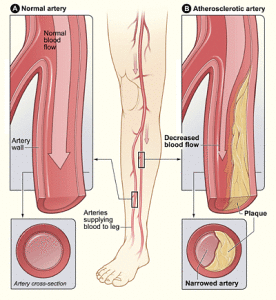What is Peripheral Artery Disease?
Peripheral artery disease (P.A.D.) is a disease in which plaque builds up in the arteries that carry blood to your head, organs, and limbs. Plaque is made up of fat, cholesterol, calcium, fibrous tissue, and other substances in the blood.
When plaque builds up in the body’s arteries, the condition is called atherosclerosis. Over time, plaque can harden and narrow the arteries. This limits the flow of oxygen-rich blood to your organs and other parts of your body.
P.A.D. usually affects the arteries in the legs, but it also can affect the arteries that carry blood from your heart to your head, arms, kidneys, and stomach. This article focuses on P.A.D. that affects blood flow to the legs.
Overview
Blocked blood flow to your legs can cause pain and numbness. It also can raise your risk of getting an infection in the affected limbs. Your body may have a hard time fighting the infection.
When severe enough, blocked blood flow can cause gangrene (tissue death). In very serious cases, this can lead to leg amputation.
If you have leg pain when you walk or climb stairs, talk with your doctor. Sometimes older people think that leg pain is just a symptom of aging. However, the cause of the pain could be P.A.D. Tell your doctor if you’re feeling pain in your legs and discuss whether you should be tested for P.A.D.
Smoking is the main risk factor for P.A.D. If you smoke or have a history of smoking, your risk of P.A.D. increases. Other factors, such as age and having certain diseases or conditions, also increase your risk of P.A.D.
Outlook
P.A.D. increases your risk of coronary heart disease, heart attack, stroke, and transient ischemic attack (“mini-stroke”). Although P.A.D. is serious, it’s treatable. If you have the disease, see your doctor regularly and treat the underlying atherosclerosis. P.A.D. treatment may slow or stop disease progress and reduce the risk of complications. Treatments include lifestyle changes, medicines, and surgery or procedures. Researchers continue to explore new therapies for P.A.D.

The illustration shows how P.A.D. can affect arteries in the legs. Figure A shows a normal artery with normal blood flow. The inset image shows a cross-section of the normal artery. Figure B shows an artery with plaque buildup that’s partially blocking blood flow. The inset image shows a cross-section of the narrowed artery.
What Causes Peripheral Artery Disease?
The most common cause of peripheral artery disease (P.A.D.) is atherosclerosis. Atherosclerosis is a disease in which plaque builds up in your arteries. The exact cause of atherosclerosis isn’t known.
P.A.D. may start if certain factors damage the inner layers of the arteries. These factors include:
- Smoking
- High amounts of certain fats and cholesterol in the blood
- High blood pressure
- High amounts of sugar in the blood due to insulin resistance or
diabetes
When damage occurs, your body starts a healing process. The healing may cause plaque to build up where the arteries are damaged.
Eventually, a section of plaque can rupture (break open), causing a blood clot to form at the site. The buildup of plaque or blood clots can severely narrow or block the arteries and limit the flow of oxygen-rich blood to your body.
Who Is at Risk for Peripheral Artery Disease?
Peripheral artery disease (P.A.D.) affects millions of people in the United States. The disease is more common in blacks than any other racial or ethnic group. Major risk factors for P.A.D. are smoking, older age, and having certain diseases or conditions.
Smoking
Smoking is the main risk factor for P.A.D. and your risk increases if you smoke or have a history of smoking. Quitting smoking slows the progress of P.A.D. People who smoke and people who have diabetes are at highest risk for P.A.D. complications, such as gangrene (tissue death) in the leg from decreased blood flow.
Older Age
Old age also is a risk factor for P.A.D. Plaque builds up in your arteries as you age. Older age combined with other risk factors, such as smoking or diabetes, also puts you at higher risk for P.A.D.
Diseases and Conditions
Many diseases and conditions can raise your risk of P.A.D., including:
- Diabetes
- High blood pressure
- High blood cholesterol
- Coronary heart disease
- Stroke
- Metabolic syndrome
What Are the Signs and Symptoms of Peripheral Artery Disease?
Many people who have peripheral artery disease (P.A.D.) don’t have any signs or symptoms.
Even if you don’t have signs or symptoms, ask your doctor whether you should get checked for P.A.D. if you’re:
- Aged 70 or older
- Aged 50 or older and have a history of smoking or diabetes
- Younger than 50 and have diabetes and one or more risk factors for atherosclerosis
Intermittent Claudication
People who have P.A.D. may have symptoms when walking or climbing stairs, which may include pain, numbness, aching, or heaviness in the leg muscles. Symptoms also may include cramping in the affected leg(s) and in the buttocks, thighs, calves, and feet. Symptoms may ease after resting. These symptoms are called intermittent claudication.
During physical activity, your muscles need increased blood flow. If your blood vessels are narrowed or blocked, your muscles won’t get enough blood, which will lead to symptoms. When resting, the muscles need less blood flow, so the symptoms will go away.
Other Signs and Symptoms
Other signs and symptoms of P.A.D. include:
- Weak or absent pulses in the legs or feet
- Sores or wounds on the toes, feet, or legs that heal slowly, poorly, or not at all
- A pale or bluish color to the skin
- A lower temperature in one leg compared to the other leg
- Poor nail growth on the toes and decreased hair growth on the legs
- Erectile dysfunction, especially among men who have diabetes
 Skip to content
Skip to content
